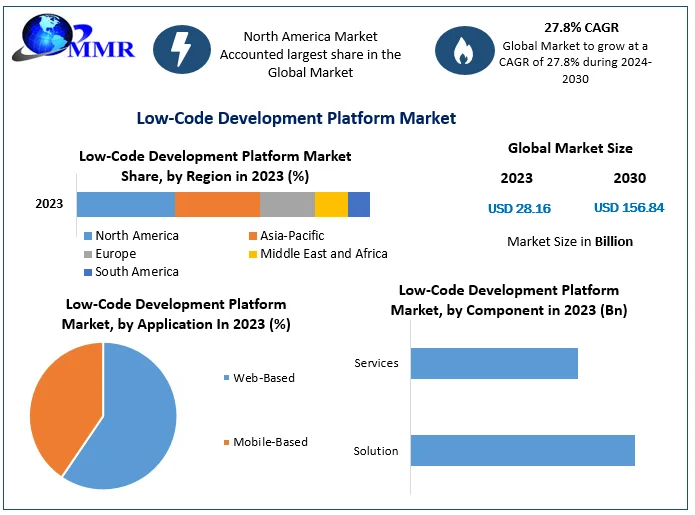New News To Picking Low-Code Platform Recommendations
New News To Picking Low-Code Platform Recommendations
Blog Article
Benefits Of Low-Code Application Development With Regard To Accessibility To Non-Developers
App development that is low-code improves accessibility by non-developers (often referred to "citizen-developers") due to several key elements.
Drag-and-Drop Builders. Low-code platforms come with drag-and-drop interfaces. This allows non-developers the ability to build applications using visuals, without having to write code. This makes development more accessible for people who have no or little technical knowledge.
WYSIWYG editor: The "What you see is what you get" editors allow users to design interfaces, workflows and other functions in a manner that closely mimics the final product. They are simpler to learn and use.
Simplified Logic and Workflow Design:
Visual Workflow Design: Users are able to easily create business processes and application logic using diagrams, flowcharts and models. They are simpler to implement than traditional coding.
Pre-built Components of Logic Low-code platforms often come with pre-built logic (e.g. loops, conditional statement) which can be easily adjusted, thus reducing the requirement for complicated programming.
Reusable templates and components:
Templates for libraries of pre-built templates Many low code platforms provide an application library that can be used for the most common types of applications, allowing non-developers a solid base to build upon and then modify.
Reusable Widgets And Modules: Users can make use of reused widgets. This simplifies the creation and reduces the need of in-depth knowledge.
Tutorials and Guided Development
Step-by-Step Guides: Platforms often provide guided development paths along with tutorials and guidelines to assist novice developers in developing applications.
Interactive Tutorials Interactive tutorials and hands-on ones let users learn by doing. They can build confidence using the platform.
Integration with tools already in use
seamless integration: Low-code platform are designed to integrate seamlessly with the existing systems, tools, and software (e.g., ERP, CRM, ERP). This enables non-developers who do not have a prior experience in programming to design applications that work with their existing workflows.
APIs and Connectors Built-in APIs and connectors ease the integration process and allow non-developers to connect their applications with external services, without requiring the need for complicated programming.
Collaboration Features:
Team Collaboration - Features such as real-time team collaboration and shared workspaces allow non-developers to work effectively alongside analysts, professionals, developers and other stakeholders.
Access Control Based On Roles: Developers who are not developers are able to be assigned roles and access levels that permit users to contribute, without compromising security or functionality.
Automated Debugging, Debugging, and Testing
Low-code platforms include tools to test and debug which are built into. They automatize this process so it is simpler for non-developers to make sure their apps work.
Platform detects problems when they occur and offers fixes. This helps non-developers with troubleshooting.
Overall, the advantage of low-code application development in terms of accessibility for non-developers is in its ability to make the development process more accessible. Low-code platforms offer intuitive visual tools, guided user experiences, and allow business users to actively take part in the creation, maintaining and updating applications. Follow the top rated Low-code Platform for application development for more tips including mobile app development platforms, rapid app development, cross platform mobile development, develop web app, application modernisation, application development platforms, stored sql procedures, microsoft azure sql, push alerts, driver jdbc and more.
Benefits Of Low-Code Applications In Safety And Governance
Low-code design of applications offers a variety of advantages in terms of security and governance. Both are crucial for ensuring that applications are safe, compliant and well-managed throughout their lifespan. Here are some of the most important advantages:
Unified Management Console: Low-code platform usually provides a central dashboard where administrators can oversee and manage all applications and ensure that the governance is consistent across the organization.
Role-Based Access Control RBAC (RBAC). These platforms typically have robust access control that is by role, which gives administrators the ability to define and implement their own access policies. This guarantees that only users who are authorized have the ability to access or modify certain areas of the application.
Compliance and Regulatory Conformity:
Many low-code platforms come with built-in compliance functions. For example, they are developed in accordance with the standards of the industry, regulations and laws (e.g. HIPAA, GDPR). They provide tools and frameworks to ensure that the applications comply with these standards.
Audit Trails and Logging Complete audit trails and logs can be integrated to enable organizations to track changes as well as monitor access to ensure the compliance.
Improve Security Measures
Data Encryption. Low code platforms usually offer built-in encrypted data during transport and when at rest. This safeguards sensitive data.
Security Certifications Many low-code vendors have security certifications (e.g. ISO 27001, SOC 2 ) that demonstrate the compliance with security standards of high quality. This provides additional assurance to the users.
Automated Security Updates
Regular patching and updates Low-code platforms can handle the majority of security patches and updates in a way. They make sure that applications are protected from the latest attacks without the need for developers to intervene manually.
Security Monitoring Tools: These instruments provide alerts that are updated in real time, and provide insights into security concerns that might be present.
Data Governance
Data Access Policy: These platforms allow organizations define and enforce policies for data access, making sure that only authorized individuals are able to access data, and the data is utilized in a safe manner.
Data Masking and Anonymization: The built-in tools to hide and anonymize data can help safeguard sensitive data when working in testing or development environments.
Consistent Application lifecycle Management
Pipelines for development and deployment: Low-code platforms provide integrated development and deployment, which includes security tests. This ensures security throughout the lifespan of the application.
Version Control: A unified version control system helps to control changes, allowing any modifications made to an application to be monitored. If required they can be reversed and the application's integrity maintained.
User Authentication and Authorization:
Single Sign On (SSO) Single Sign On (SSO): Single sign-on and other advanced authentication methods reduces the burden of managing users and increases security.
Multi-Factor Authentication Numerous platforms can support multi-factor Authentication that adds an additional layer of security when accessing applications.
Policy Enforcement and Compliance Monitoring:
Policy Templates: Low-code platforms often come with pre-defined policy templates which help companies quickly implement security and governance policies.
Compliance Monitoring Tools - These tools provide constant checking of compliance status, and also provide the ability to report, making it easier to identify and resolve possible issues.
Integration with Existing Security Infrastructure
Seamless integration: Low-code platforms can easily be integrated into existing security tools and devices like firewalls, SIEM products (Security Information and Event Management), and identity management systems.
API Security: Built-in API security features ensure that integrations with external systems are safe, safeguarding the integrity of data as well as ensuring that applications remain secure.
Training and best Practices
Good practices: Several platforms provide guidelines for developing secure apps, as well as best practices. This assists non-developers to comply with security standards.
Security Training: Some low-code companies offer security training and tools to help users learn how to build and maintain secure applications.
The governance and security features of low-code applications make sure that they are developed and maintained in a compliant and controlled way. These platforms come with the frameworks and tools required to safeguard sensitive data and enforce policies, while ensuring regulatory compliance. Read the top recommended reading on Enterprise application development with Low-code Platform for blog examples including rapid applications, app platforms, develop web app, software for app development, ms azure sql, mobile development platforms, cross platform mobile dev, cross platform app development, microsoft azure sql, stored sql procedures and more.
Benefits Of Low-Code App Development In Terms Limitations And Customization
Low-code application development is a balancing solution that has significant advantages in terms of overcoming limitations while also allowing customization. These are the main advantages: Resolving limitations
: .
Simplified Development : Low-code platform reduces the complexity of development by supplying templates and components that are pre-built, allowing for faster creation and deployment.
Guided Workflows: Many platforms have guided workflows as well as wizards that help developers navigate through complicated processes, reducing the chance of making mistakes and guaranteeing consistency.
Scalability Solutions:
Scalability is built into low-code platforms. They typically have features that enable scaling architecture. This allows applications to take on more load without major redevelopment.
Performance Monitoring Performance Monitoring Tools: Integrated performance monitoring tools and optimization make sure that applications are as efficient as they can be, regardless of their size.
Security and Compliance
Low-code platforms have built-in security features such as role-based security access control, encryption, and automated checks for security compliance. These measures address the common concerns about security.
Regular Updates: Platforms frequently update their security protocol and compliance measures. This makes sure that applications remain protected against emerging threats.
Customization Options:
Extensibility:
Custom Code Integration: Low-code platforms often permit the integration of custom codes (e.g., JavaScript, Python) that allows developers to enhance the functionality beyond what is available in the standard features.
Modifications and plugins that are custom Developers can design custom plugins or modules to include specific functions that are tailored to unique business requirements.
APIs and integration:
API Support - Complete API support allows seamless integration with external services and systems and permits extensive customization.
Third-Party Service: Low-code platforms offer pre-built connectors for popular third-party service providers, making it easier to add and modify applications.
Flexible UI/UX Design
Customizable User Interfaces: Designers are able to alter and design user interfaces that comply with the specifications for branding and usability to create a custom user experience.
Responsive Design: The built-in capabilities of responsive design guarantee that applications are able to be customized for different devices and screen sizes.
Business Logic Customization
Visual Workflow Builders: Visual tools for designing and customizing workflows and business logic enable developers to create complex, tailored workflows without code.
Platforms can provide conditional logic to adapt to specific business rules or scenarios.
Data Management
Custom Data Models: Developers have the option to design custom data models for specific applications, and tailoring the handling of data to meet specific business needs.
Advanced Data Processing: Integration with the latest tools and capabilities for data processing allows for customization in the way that data is analysed and used within the application.
Balanced Limitations and Customization
Frameworks and Standards
Best Practices for Compliance: Low-code platforms encourage adhering to industry best practices and standards. This assists in maintaining high-quality scalable, and secure applications.
Governance Frameworks built-in governance frameworks guarantee that the customizations don't compromise the integrity, security or the compliance of the application.
Iterative Development:
Rapid Prototyping: The capacity to quickly prototype and test changes allows developers to iterate based on user feedback improving the app to better meet user needs.
Continuous Improvement: Low-code systems allow continuous improvement, allowing for continuous customization and improvement when business requirements change.
User Empowerment
Giving Citizen Developers the tools they need: Low-code platforms can increase the number developers who are capable of improving and customizing applications, by permitting them to create custom intuitive user interfaces.
Training and Support: A lot of platforms provide comprehensive training and support to assist users with successful modifications that do not compromise the stability of the application, or its performance.
In general, low-code application development offers a solid framework that can address the weaknesses and provides a wide range of possibilities for customization. This allows companies to develop and maintain functional applications designed to meet their requirements while maintaining high standards for quality, security and the ability to scale.
